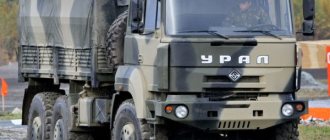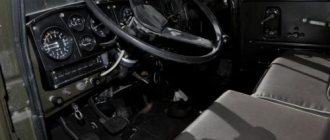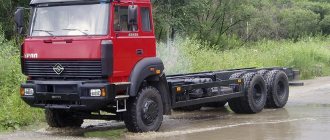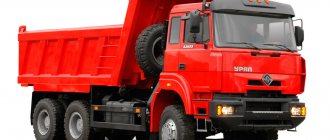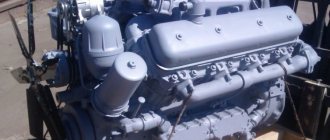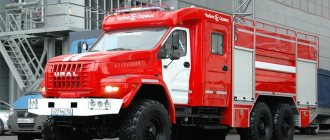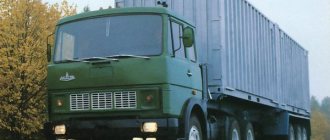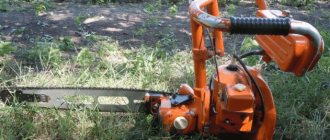Off-road vehicle from UralAZ
Ural-44202 is a family of off-road truck tractors with a 6x6 wheel arrangement. These are trucks that traveled through Siberia, the Far North, and the Far East together with our oil, gas, and military workers, and received serious modernization in the early 2010s. These vehicles are designed for transporting goods on roads and off-roads as part of a road train - with a semi-trailer. They are well adapted for operation in harsh climatic conditions, have a high load capacity, and are very unpretentious in operation and maintenance.
Classic serial truck tractors based on the Ural-4320
Developed on the basis of the classic 4320 family, the Ural-44202 truck tractors are intended for towing semi-trailers on all types of roads and off-road. The main semi-trailers for these trucks are models 9355 and 9516.
Ural-44202-0311-31 is a truck tractor with a gross weight of 17.72 tons and a YaM3-238M2 diesel engine with a power of 176 kW (240 hp)
Ural-44202-0311-41 is a truck tractor with a gross weight of 17.3 tons and a YaM3-2Z6NE2 diesel engine with a power of 169 kW (2Z0 hp)
Ural-44202-0511-41 is a truck tractor with a gross weight of 17.3 tons and a YaM3-2Z6NE2 diesel engine with a power of 169 kW (230 hp) and an “increased volume” cabin (extended, with a berth).
Their technical characteristics:
- Overall dimensions: length – 7.143 m, width – 2.5 m (excluding rear-view mirrors), height – 2.74 m.
- Wheelbase: 3.525 + 1.4 m.
- Outer turning radius: 11.6 m.
- Load capacity 8.1 t.
- Gross vehicle weight: 17.3 tons.
- Permissible total weight of the road train: 30.62 tons.
- The capacity of the diesel fuel tank is 300 liters.
- Maximum speed – 72 km/h.
The history of the creation of the basic car chassis
Since the early sixties of the 20th century, the Ural plant began to produce a truck of its own design - the Ural-375.
With all the positive qualities in cross-country ability, which was very important at that time, this car had a serious drawback: a gasoline engine that consumed a huge amount of high-quality fuel - 50-60 liters per 100 km.
In 1977, it was replaced by the Ural-4320.
It was originally planned in several modifications and was intended for the transport of various goods and people, as well as for the transport of trailers and trailers.
Due to the fact that at its base it was designed as an all-wheel drive vehicle with three drive axles, the Ural-4320 easily traversed difficult roads and swampy areas, and was also capable of fording up to one and a half meters deep.
This was facilitated by the sealing of all main components of the engine and machine during manufacturing and assembly.
The filling capacities of truck fuel tanks allow you to take on board up to 300 liters of diesel, and in some modifications – up to an additional 60 liters.
Further changes in the technical characteristics of this tractor made it possible to create a vehicle that was capable of driving off-road, regardless of the condition of the ground.
Do you know why the Tatra-148 truck is still in demand today? This article describes what types of vans the Hyundai Porter can be equipped with.
Military applications
Thanks to its unique characteristics, the Ural-4320 was very popular in the USSR Armed Forces.
During the fighting in Afghanistan, another quality of this vehicle was revealed. When a mine exploded, the personnel in the back did not receive injuries or concussions. The explosion of an armored personnel carrier guaranteed one hundred percent concussion.
The basic serial Ural-4320 was produced from 1977 to 1986. It was replaced by the Ural-4320-01 with a new on-board platform, which was produced until 1993.
Engines YaMZ-236NE2 and YaMZ-238M2
YaMZ-236NE2 is a turbocharged four-stroke six-cylinder diesel engine with a working volume of 11.15 liters, with a V-shaped cylinder arrangement, with compression ignition, direct injection of diesel fuel, liquid cooling, with intermediate cooling of the charge air in the heat exchanger. The power is 169 kW (230 hp). The maximum torque is 882 N.m (90 kgf.m). Cylinder diameter – 130 mm, piston stroke – 14О mm.
YaM3-238M2 is a V-shaped eight-cylinder diesel engine with a working volume of 14.86 liters, four-stroke with compression ignition, direct fuel injection, and a liquid cooling system. The power is 176 kW (240 hp). The maximum torque is 883 N.m (90 kgf.m). Cylinder diameter – 130 mm, piston stroke – 14О mm.
Van fuel consumption standards
For vans, the standard value of fuel consumption is determined similarly to on-board trucks using formula (3).
For vans operating without taking into account the weight of the cargo being transported, the normalized value of fuel consumption is determined taking into account an increasing correction factor - up to 10% of the base standard.
Fuel consumption standards for vans of domestic manufacturers
| Model, brand, modification of the car | Basic rate, l/100 km | Fuel |
| BAGEM 27856V (D-245.7E2-4L-4.75-117-5M) | 19,5 | D |
| VIS-2345-0000012 (VAZ-2106-4L-1.57-75.5-4M) | 9,3 | B |
| GAZ-2705 (ZMZ-4026.10-4L-2,445-100-5M) | 15,0 | B |
| GAZ-2705 (ZMZ-5143.10-4L-2.24-98-5M) | 11,3 | D |
| GAZ-2705 (g/p; ZMZ-4062.10-4L-2.3-150-5M) | 14,5 | B |
| GAZ-2705 (g/p; ZMZ-405220-4L-2,464-145-5M) | 15,1 | B |
| GAZ-2705 (g/p; ZMZ-40260F-4L-2,445-86-5M) | 16,2 | B |
| GAZ-2705 (g/p; ZMZ-405220-4L-2,464-140-5M) | 14,7 | B |
| GAZ-2705 (g/p; ZMZ-40630A-4L-2.3-110-5M) | 14,3 | B |
| GAZ-2705 (g/p; ZMZ-405220-4L-2,464-140-5M) | 14,5 | B |
| GAZ-2705 (g/p; UMZ-4215СО-4L-2.89-110-5М) | 16,0 | B |
| GAZ-2705 (UMZ-421500-4L-2.89-96-5M) | 17,4 | B |
| GAZ-2705ADCh (9 seats; ZMZ-405220-4L-2 464-140-5M) | 17,7 | B |
| GAZ-2705AZ (9 seats; ZMZ-405220-4L-2,464-140-5M) | 17,1 | B |
| GAZ-2705AZ (13 seats; ZMZ-40630A-4L-2.3-98-5M) | 16,5 | B |
| GAZ-2705-014 (ZMZ-4063-4L-2.3-110-5M) | 15,0 | B |
| GAZ-2705-034 “Combi” (g/p ZMZ-40630A-4L-2.3-110-5M) | 15,3 | B |
| GAZ-270500-44 (ZMZ-4026.10-4L-2,445-100-5M) | 16,0 | B |
| GAZ-27057-034 (ZMZ-4063A-4L-2.3-110-5M) | 16,9 | B |
| GAZ-27057ADCh (7 seats; ZMZ-40630A-4L-2.3-98-5M | 15,9 | B |
| GAZ-27057ADCH (7 seats; SGU ZMZ-40630A-4L-2.3-98-5M) | 16,6 | B |
| GAZ-27181 (ZMZ-4025.10-4L-2,445-90-5M) | 17,3 | B |
| GAZ-27181 (ZMZ-4025.10-4L-2,445-100-4M) | 17,7 | B |
| GAZ-2747 (g/p; ZMZ-4063D-4L-2.3-110-5M) | 16,2 | B |
| GAZ-2752 “Sobol” (ZMZ-4063-4L-2.3-110-5M) | 14,0 | B |
| GAZ-2752 “Sobol” (g/p ZMZ-40630С-4L-2,3-98-5М) | 13,5 | B |
| GAZ-2752 “Sobol” (ZMZ-40630A-4L-2.3-110-5M) | 13,7 | B |
| GAZ-2752-0000010″Bison-2000″ (armor ZMZ-4063.10-4L-2.3-110-5M) | 15,4 | B |
| GAZ-2752-414 (g/p; ZMZ-40522A-4L-2,464-140-5M | 14,3 | B |
| GAZ-27527 (g/p; ZMZ-40522A-4L-2,464-145-5M) | 15,4 | B |
| GAZ-2757AO (ZMZ-4063A-4L-2.3-110-5M) | 16,0 | B |
| GAZ-2968 O'gara-Bizon (armored, GAZ-2752 chassis) (ZMZ-4063С-4L-2,3-98-5М) | 15,3 | B |
| GAZ-32590N (operational headquarters with SGU ZMZ-405220-4L-2,464-140-5M) | 16,5 | B |
| GAZ-33021 “Warrior” (armored ZMZ-4026-4L-2,445-100-5M) | 19,0 | B |
| GAZ-33021-1214, ZSA-27071 (ZMZ-4026.10-4L-2,448-100-5M) | 17,5 | B |
| GAZ-33022 (ZMZ-4025.10-4L-2,446-90-5M) | 16,5 | B |
| GAZ-33022-0000310 (ZMZ-4026.10-4L-2,445-100-5M) | 16,2 | B |
| GAZ-33027 (armored, ZMZ-40630A-4L-2.3-110-5M) | 17,6 | B |
| GAZ-33094 (GAZ-5441.10-4L-4.15-116-5M) | 17,8 | D |
| GAZ-37972 (ZMZ-40630A-4L-2.3-98-5M) | 16,4 | B |
| GZSA-3702, -(KMZ)-3712 | 23,0 | B |
| GZSA-37021, -37041 | 34,0 | CIS |
| GZSA-37022, -37042 | 24,0 | LNG |
| GZSA-3704 | 23,0 | B |
| GZSA-3706, -(KMZ)-3705, -3711, -37111, -37112, -3712*(2)* | 27,0 | B |
| GZSA (KMZ)-37122 | 24 (23) | LNG |
| GZSA-3713, -3714 | 29,0 | B |
| GZSA (KMZ)-3716 | 28,0 | B |
| GZSA (KozMZ)-3718*(3) | 29,0 | B |
| GZSA (KozMZ)-3719 | 29,0 | B |
| GZSA (KMZ)-3721 | 27,0 | B |
| GZSA (KMZ)-37231 | 27,0 | B |
| GZSA (KMZ)-3726 | 27,0 | B |
| GZSA-3742, -37421 | 29,0 | B |
| GZSA-376820 | 27,0 | B |
| GZSA-3944 | 27,0 | B |
| GZSA-731*(1) | 29,0 | B |
| GZSA-890A | 34,0 | CIS |
| GZSA-891, -892, -893A | 23,0 | B |
| GZSA-891V, -893B | 24,0 | LNG |
| GZSA-893AB | 34,0 | CIS |
| GZSA-947 | 29,0 | B |
| GZSA-949, -950 | 27,0 | B |
| GZSA-950A | 39,0 | CIS |
| DISA-29521 (armored, sh.GAZ-2752) (GAZ-560-4L-2,134-95-5M) | 11,4 | D |
| DISA-2955 (armored, w. ZIL-5301) (D-245-4L-4.75-107-5M) | 19,3 | D |
| ErAZ-37111 | 28,0 | B |
| ErAZ-37121 | 24,0 | B |
| ErAZ-373, -37301, -37302, -37304, -37305 | 15,0 | B |
| ErAZ-762, -762A, -762B, -762V | 14,0 | B |
| ZIL-433360 (ZIL-508.10-8V-6.0-150-5M) | 34,5 | B |
| ZIL-433362 (ZIL-508.10-8V-6.0-150-5M) | 35,0 | B |
| ZIL-47410A (sh. ZIL-5301) (D-245.12-4L-4.75-109-5M) | 15,1 | D |
| ZIL-474110 (ZIL-508.10-8V-6.0-150-5M) | 34,2 | B |
| ZIL-474110 (sh. ZIL-433362) (D-245.12-4L-4.75-109-5M) | 17,7 | D |
| ZIL-5301 EO (D-245.12-4L-4.75-109-5M) | 15,2 | D |
| ZIL-534332 (YaMZ-236A-6V-11.15-195-5M) | 26,5 | D |
| IZH-2715, -27151, -271501, -27151-01 | 11,0 | B |
| IZH-2715011 | 15,0 | CIS |
| IZH-27156-016 (UZAM-412E-4L-1,584-80-4M) | 10,0 | B |
| IZH-2717 (VAZ-2106-4L-1,569-75-5M) | 9,4 | B |
| IZH-2717-220 (UMPO-331410-4L-1,699-85-5M) | 9,7 | B |
| IZH-2717-230 (VAZ-2106-4L-1,569-75-5M) | 9,5 | B |
| KavZ-49471 | 53,0 | B |
| KavZ-664 | 29,0 | B |
| KamAZ-43114R (KAMAZ-740.31-8V-10.85-240-10M) | 32,0 | D |
| KamAZ-53212 (YaMZ-238M2-8V-14.86-240-5M) | 31,5 | D |
| KamAZ-53212A (KAMAZ-7403.10-8V-10.85-260-10M) | 30,6 | D |
| KamAZ-532150 (KAMAZ-740.11-8V-10.85-240-10M) | 28,0 | D |
| KamAZ-65201 (KAMAZ-740.50-8V-11.76-360-16M ZF | 46,5 | D |
| Kuban-G1A1 | 28,0 | B |
| Kuban-G1A2 | 30,0 | B |
| Kubanets-U1A | 18,0 | B |
| MAZ-53371 (YaMZ-236M2-6V-11.15-180-5M) | 26,2 | D |
| MAZ-53366 (YaMZ-238M2-8V-14.86-240-6M) | 25,0 | D |
| LuMZ-890, -890B | 34,0 | B |
| LuMZ-945, -948 | 10,0 | B |
| LuMZ-946, -949 | 15,0 | B |
| Maud. (KMZ)-35101 | 27,0 | B |
| Maud. (GZSA)-3767 | 28 (27) | LNG |
| Maud. (KMZ)-39011 | 24,0 | B |
| Maud. (KozMZ)-39021, -39031 | 29,0 | B |
| Maud. (KMZ)-54423 | 28,0 | D |
| Maud. (KozMZ)-5703 | 28,0 | D |
| Moskvich-2733, -2734 | 11,0 | B |
| NZAS-3964*(4) | 29,0 | B |
| NZAS-4208 | 35,0 | D |
| NZAS-4947 | 53,0 | B |
| NZAS-4951 | 34,0 | D |
| PAZ-3742 | 29,0 | B |
| PAZ-37421 | 28,0 | B |
| Ratnik-29453 (gaz-2705 highway) (ZMZ-40630A-4L-2.3-98-5M) | 16,0 | B |
| Ratnik-29453 (gaz-2705 highway) (ZMZ-40522-4L-2,464-140-5M) | 16,1 | B |
| RAF-22031-1, -22035, -22035-01 | 15,0 | B |
| RIDA-222210 (sh.GAZ-2705) (ZMZ-40630A-4L-2.3-98-5M) | 15,3 | B |
| RIDA-222211 (s.GAZ-27057) (GAZ-560-4L-2,134-95-5M) | 13,7 | D |
| UAZ-3303-0001011APV-04-01 (4L-2,445-92-4M) | 17,5 | B |
| UAZ-3741 (UMZ-4178-4L-2,446-90-4M) | 16,5 | B |
| UAZ-3741 (UMZ-4178-4L-2,446-76-4M) | 16,8 | B |
| UAZ-3741 "DISA-1912 Zaslon" (4L-2,445-92-4M) | 17,6 | B |
| UAZ-374101, -396201 | 17,0 | B |
| UAZ-3909 (g/p) (UMZ-4178-4L-2,445-90-4M) | 16,5 | B |
| UAZ-3909 (g/p) (UMZ-4178-4L-2,445-76-4M) | 18,5 | B |
| UAZ-3909 (g/p) (ZMZ-40210L-4L-2,445-81-4M) | 17,3 | B |
| UAZ-3909 (UMZ-4178-4L-2,446-92-4M) | 16,8 | B |
| UAZ-39099 “Farmer” (g/p) (UMZ-4218.10-4L-2.89-98-4M) | 18,0 | B |
| UAZ-390992 (g/p; ZMZ-410400-4L-2.89-85-4M) | 17,0 | B |
| Ural-326031 (YaMZ-236NE2-6V-11.15-230-5M) | 29,9 | D |
| Ural-4320-0111-41 (armored) (YaMZ-236NE2-6V-11.15-230-5M) | 33,3 | D |
| Ural-49472 | 53 | B |
*(1) GZSA - Gorky Specialized Vehicles Plant
*(2) KMZ - Caspian Machine-Building Plant
*(3) KozMZ - Kozelsky Machine-Building Plant
*(4) NZAS - Neftekamsk dump truck plant
Fuel consumption of frogs from foreign manufacturers
| Model, brand, modification of the car | Basic rate, l/100 km | Fuel |
| Avia A-20F | 11,0 | D |
| Avia A-30F, -30KSU, -31KSU | 13,0 | D |
| Guk A-03, A-06, A-07M, A-11, A-13, A-13M | 14,0 | B |
| Ford Accorn F 150 (armored, 6V-4,2-210-5M) | 16,0 | B |
| Ford E-350 (armor, 8V-5.77-210-4A) | 23,0 | B |
| Ford Econoline E350 (armor, 8V-5.77-210-4A) | 21,0 | B |
| Ford Econoline E350 (armor, 8V-5,4-232-4A) | 21,5 | B |
| Ford Econoline F 450 (armor, 8V-7,498-245-5M) | 32,0 | B |
| Ford Transit 100C (armor, 4L-1,994-115-5M) | 16,2 | B |
| Ford Transit 2.5D (4L-2,496-70-5M) | 8,4 | D |
| Ford Transit Connect 1.8TD (c/m. 4L-1,753-90-5M) | 8,2 | D |
| Ford Transit FT 150/150L 2.5 T (4L-2,498-85-5M) | 10,5 | D |
| Ford Transit FT-190L (4L-2,496-76-5M) | 9,0 | D |
| IFA-Robur LD 3000KF/STKo | 17,0 | D |
| Isuzu 27958D (4L-4.57-121-5M) | 16,2 | D |
| Iveco 50.9, -60.11 (4L-3,908-100-5M) | 13,8 | D |
| Iveco 65.10 (4L-3,908-100-5M) | 14,6 | D |
| Iveco 79.12 (4L-3,908-115-5M) | 14,7 | D |
| Iveco Daily 49.10 (4L-2.5-103-5M) | 13,0 | D |
| Iveco Euro Cargo (6L-5,861-143-6M) | 19,4 | D |
| Iveco Euro Cargo ML 150 E 18 (armor 6L-5,861-177-9M) | 23,0 | D |
| Iveco MT-190 E 30 (armored, 6L-9.5-345-16M) | 28,0 | D |
| MAN 15.220 (6L-6,871-220-6M) | 22,0 | D |
| MAN 15.224 LC (6L-6,871-220-6M) | 22,6 | D |
| MAN 8.145 4.6D (4L-4.58-140-5M) | 15,4 | D |
| Mercedes-Benz 1317 (6L-5,958-165-6M) | 20,7 | D |
| Mercedes-Benz 1838L (8V-12,756-381-16M) | 25,8 | D |
| Mercedes-Benz 308D (armored, 4L-2,289-79-5M) | 10,8 | D |
| Mercedes-Benz 312D (5L-2,874-122-5M) | 11,5 | D |
| Mercedes-Benz 312D (armored, 5L-2,874-122-5M) | 13,7 | D |
| Mercedes-Benz 408D (4L-2,299-79-5M) | 10,0 | D |
| Mercedes-Benz 408D (armored, 4L-2,299-79-5M) | 11,4 | D |
| Mercedes-Benz 410 (armored, 4L-2,297-105-5M) | 16,0 | B |
| Mercedes-Benz 410D (armored, 5L-2,874-95-5M) | 14,5 | D |
| Mercedes-Benz 416CDI Sprinter 2.7D (armor 5L-2,686-156-5M) | 15,5 | D |
| Mercedes-Benz 609D (4L-3,972-90-5M) | 14,3 | D |
| Mercedes-Benz 809D (4L-3,729-90-5M) | 13,1 | D |
| Mercedes-Benz 811D (4L-3,729-115-5M) | 13,8 | D |
| Mercedes-Benz 814D (6L-5,958-132-5M) | 18,9 | D |
| Mercedes-Benz LP 809/36 (4L-3.78-90-5M) | 17,0 | D |
| Mercedes-Benz Sprinter 414 2.3 (armor 4L-2,295-143-5M) | 17,8 | B |
| Mitsubishi L400 2.5 D (4L-2,477-99-5M) | 10,3 | D |
| Nusa C-502-1, C-521С, C-522С | 14,0 | B |
| Renault Kangoo 1.4 (4L-1.39-75-5M) | 8,6 | B |
| Renault Kangoo Express 1.4 (4L-1.39-75-5M) | 8,3 | B |
| TA-943A, -943N | 22,5 | B |
| TA-949A, -1A4 | 24,0 | B |
| Volkswagen LT 35 (4L-2,799-158-5M) | 11,0 | D |
| Volkswagen Transporter (4L-2.0-84-5M) | 11,0 | B |
| Volkswagen Transporter 1.9D 7H (4L-1,896-86-5M) | 9,8 | D |
| Volkswagen Transporter 2.5 (armor 5L-2,459-110-5M) | 13,5 | B |
| Volkswagen Transporter T4 2.5 (armor 5L-2,461-115-5M) | 14,1 | B |
| Volkswagen Transporter T4 2.5 syncro (armor. 5L-2,459-110-5M) | 16,0 | B |
| Volkswagen Transporter T4 2.5D (armor. 5L-2,461-102-5M) | 10,5 | D |
| Volkswagen Transporter T4/T4 (armor 5L-2,37-78-5M) | 10,5 | D |
| Volvo FL 10 (6L-9,607-320-14M) | 27,0 | D |
| Volvo FL 608 (6l-5,48-180-6M) | 19,7 | D |
| Volvo FL 614 (6L-5.48-180-6M) | 21,2 | D |
| Volvo FL 626 5.5D (6L-5.48-220-9M) | 25,0 | D |
| DISA-29615 (armored, Ford Transit (4L-2,295-146-5M) | 14,2 | B |
| DISA-296151 (armored, Ford Transit Connect) (4L-1,753-90-5M) | 9,0 | D |
| NAME-M19282 (armored, Ford Transit) (4L-2,402-125-5M) | 13,5 | D |
Chassis Ural-44202
The frame of the Ural-44202 car is riveted, consisting of two stamped spars of variable cross-section, which are connected to each other by 6 cross members and a front buffer.
The front suspension consists of 2 longitudinal semi-elliptical springs, operating together with hydraulic shock absorbers of a telescopic type of 2-way action. The upper lugs of the shock absorbers are attached to the bracket brackets through rubber bushings, and the lower lugs are attached to brackets welded to the axle housing. Hydraulic shock absorbers dampen vibrations resulting from elastic deformations of the truck's suspension elements when it moves over various uneven surfaces.
The rear suspension is of the balancing type, the ends of the springs are inserted into the eyes of the support brackets. The springs are attached by stepladders to balancers that swing on the axis of the balancer. Brackets are pressed onto the axle, each of which is attached to the balancer brackets with four bolts. Pushing and braking forces are transmitted from the axles to the frame through 2 upper and 4 lower reaction rods. Lateral forces are transmitted through springs.
The reaction rod joints are ball joints. Pins with a shortened cone are mounted on the upper reaction rods on the side of the bridges, which are kept from turning in the brackets by segment keys. The head of the reaction rod is sealed on one side by a gasket, which is installed under the cover, and on the other by an O-ring. The impacts of the axles on the frame, resulting from vehicle wheels hitting obstacles, are softened by a buffer. We limit the downward movement of the axles by pinching the end of the spring in the support bracket
Steering
The steering system includes the following elements: steering column, steering mechanism, steering drive and hydraulic booster. On truck tractors, various types of steering were used, namely: with a steering mechanism of the “worm-side sector” or “screw-ball nut-rack-sector” type. The steering column is connected to the steering mechanism by means of cardan shafts through an intermediate support. The design of the intermediate support uses closed type bearings that do not require lubrication.
Transmission Ural patrol
| URAL-4320: standard fuel consumption per 100 km and the dependence of consumption on performance characteristics Standard fuel consumption l for special vehicles that perform the main work while moving is determined as follows: Qн 0.01 x Hsc x S Hs x S x 1 0.01 x D, 6 where Hsc is the individual fuel consumption rate for the mileage of a special vehicle, l 100 km; S is the mileage of the special vehicle to the place of work and back, km; Hs is the rate of fuel consumption per mileage when performing special work while moving, l 100 km; S—vehicle mileage when performing special work while moving, km; D - total relative premium or reduction to the norm; when operating equipment, only premiums for work in winter and in mountainous areas are applied. Well drilling rigs, cranes, lifts There are few types of special equipment that could not be used in conjunction with the chassis of the most popular all-terrain vehicle of the Ural Automobile Plant. |
- Body length Ural 4320 – 736.6 cm.
- The width of the Urals is 250 cm.
- Height – 287 cm.
- Wheel base – 352.5 cm.
- Front track – 200 cm.
- Rear track – 200 cm.
- Clearance parameter – 40 cm.
- The smallest turning radius is 1140 cm.
- The curb weight of the URAL is 4320 – 8050 kg.
- The total weight of the URAL 4320 is 15205 kg. This is how much a Ural car weighs in working condition.
Brake systems Ural-44202
The truck is equipped with separate brake systems - service, spare, parking and auxiliary. The working brake system is drum type, with internal pads that are interchangeable for all wheels. Each brake mechanism has 2 hydraulic cylinders located in one housing. Brake pads are installed on supporting axles. The working brake mechanism is adjusted as the linings wear out by reducing the gap between the lining and the drum using eccentrics.
The drive of the brake mechanisms is of a mixed type (pneumohydraulic), dual-circuit type, with separate braking of the wheels of the front drive axle and two rear drive axles. The control is carried out by a pedal in the driver's cabin, which is connected by levers and rods to a 2-section brake valve. A mixed (pneumohydraulic) drive of service brakes is installed with a combined drive of the trailer and with additional braking devices. The compressor supplies compressed air through a pressure regulator to the safety valve block. The unit consists of triple and single safety valves that distribute and fill air cylinders of independent circuits; front wheel brake drive; drive the brake mechanisms of the middle and rear wheels.
The compressor is installed piston type, non-direct flow, 2-cylinder, single-stage compression. Pneumatic brake boosters with master brake cylinders are installed under the cabin: the first of them is on the left side member, and the second is on the fuel tank bracket. When you press the brake pedal, the valve in the brake valve opens and air flows through the pipeline under the pneumatic booster pistons.
The triple safety valve is designed to separate the compressed air that comes from the compressor into 2 main and 1 additional circuits; to automatically shut down one of the circuits when its seal is broken and preserve compressed air in all circuits in the event of damage or leakage of the supply line.
The role of a spare brake system is performed by one of the circuits of the working brake system. If one of the circuits fails, the backup brake system will ensure that the truck is braked with sufficient efficiency. The parking brake system is represented by a drum-type parking brake with 2 shoes and self-reinforcing. The auxiliary braking system is a compression-type brake that reduces the speed of the vehicle on long descents by creating back pressure in the engine exhaust gas pipelines when they are closed with flaps.
Fifth wheel coupling
On Ural-44202 tractors, a fifth-wheel coupling device with a locking hole is mounted in grips with a diameter of 5O.8 mm G0ST 12O17-81. It articulates the tractor and the semi-trailer, which has a standard kingpin. The saddle on which the semi-trailer rests swings in the longitudinal and transverse planes.
The coupling of the saddle with the semi-trailer kingpin is carried out by two grippers of the coupling mechanism. The grips are installed on fingers 14 and, rotating on them, cover the king pin. They are held in the closed position by the locking knuckle using a spring that is mounted on the locking knuckle rod. After coupling is completed, the self-release safety device takes a vertical position.
Cabin Ural-44202
The cabin of Miass truck tractors is standard Ural - closed, three-seater, with a blind wind window and thermal insulation, located behind the engine and equipped with rear-view mirrors on the left and right sides. It is attached to the truck frame at four points, on rubber pads. In cases of frame deformation, elastic fastening protects parts of the cabin from overstress.
In the cockpit of the classic Ural-44202.
The cabin doors are equipped with locks and window lifts, the windshield is equipped with a pneumatic washer and wiper. The atmosphere in the cabin is heated by air heated in the heater, which is included in the engine cooling system. The driver and passenger seats are separate; rubber belts and sponge rubber serve as shock-absorbing elements.
Transitional models of truck tractors Ural-44202
Since March 2011, the model range of the Ural-44202 family of truck tractors has been replenished with a new member - Ural-44202-59 . It is noticeably different from its predecessors, first of all, in the new cabin (instead of the same one that for four decades formed the basis of the appearance of Miass trucks). The new cabin, with the index “P”, was created in collaboration with. It is, of course, not an example of modern design, but it is noticeably quieter, warmer and more spacious than the “classic Ural” one.
Ural-44202-59.
Convenient mirrors and a significant glazing ratio provide good visibility. The mirrors consist of a side-view mirror and a wide-angle mirror. The driver's seating position is high. Passenger seats in the new saddles are separate, anatomically shaped, equipped with seat belts, with headrests and armrests. The driver's seat is equipped with a suspension system. The steering column is tilt adjustable; The steering wheel is of a new type.
Since the transfer case received a pneumatic drive, the outdated lever was replaced with a switch on the dashboard, which allows you to control the transfer stages and, if necessary, lock the center differential.
At the XII International Exhibition of Commercial Vehicles Comtrans-2O1Z UralAZ brought out a modernized truck tractor Ural-442O2-3511-8O , equipped with a new generation diesel engine YaM3-5Z6. Serial production of the new version of the fifth wheel, using Ivekov cabs in both hooded and hoodless configurations, began in 2014. In addition to the progressive diesel engine, the Ural-442O2-3511-8O is also equipped with modernized drive axles, a pneumatic drive of the brake system, a transfer case, ZF and Fast Gear gearboxes.
A redesigned transfer case with increased input torque and a modified pneumatic drive improves ergonomics and increases unit reliability. The air brake system was developed using components from Wabco. The new RBL integral steering gear further reduces steering forces and improves overall steering reliability, while also providing opportunities to reduce maintenance and repair costs.
Due to the modernization of components and assemblies, the carrying capacity of the new fifth wheel increased to 13 tons, the total weight of the truck - up to 22.5 tons, the total weight of the road train - up to 38 tons, the load on the front axle - up to 6.5 tons. The new truck has a lower average diesel fuel consumption (at the level of 36 l/100 km), the frequency of scheduled maintenance has been increased (up to 15 thousand km), the warranty period has been increased (up to 50 thousand km or 18 months), The declared life of the car has increased to 350 thousand kilometers.
Ural Wolf • Ural gear-up
| Ural-44202: characteristics and prices, photographs and review Since these machines are often used in Northern conditions, all the options that are installed on the forty are also used when completing the Ural 4320-41. The use of heaters is expected in the winter when cars operate according to fuel consumption standards using winter allowances, as well as in the cold season when the average daily temperature is below 5 degrees. |
| What is the fuel consumption of the Ural 4320 and on what factors does it depend? The Ural-5557 is capable of moving on any off-road terrain, including arable land; drive next to a tractor or combine at a speed of 3-5 km h without any problems for a diesel engine. For dump trucks and road trains, the fuel consumption rate Hz is additionally established for each trip with a load when maneuvering at loading and unloading points - up to 0.25 liters of liquid fuel, up to 0.33 liters of liquefied petroleum gas, up to 0.25 cubic meters. |
Arc on the left side: • Externally it was distinguished by a deep tray, a seat with 4 studs for a magneto instead of a generator.
Technical characteristics of the new Ural 44202 truck tractors
In the Urals-442O2-3511-8O the cabin is double. Its interior is like this.
- Overall dimensions: length – 7.525 m or 7.625 m (with extended cab), width – 2.5 m (excluding side mirrors), height – 3.085 m.
- The weight of the tractor in running order is 8.99 / 8.545 tons.
- The total weight of the road train is 38 tons.
- The permissible load on the fifth wheel coupling is 10 tons.
- The total weight of the towed semi-trailer is 28,605 tons.
- Fuel tank capacity – 30 liters.
New YaMZ-536 engines
The YaMZ-536 engine is installed on a number of modern models of Ural off-road vehicles with 4x4 and 6x6 wheel arrangements. These are six-cylinder in-line four-stroke diesel engines that meet the requirements of the Euro-4 standard. The working volume of this engine is 6.65 liters. Cylinder diameter – 105 mm, piston stroke – 128 mm. The cooling system is liquid, there is a turbocharger with cooling of the charge air in the heat exchanger.
The YAM3-5Z6 engine is equipped with a battery-type fuel system (ECRS) produced by , which provides an injection pressure of 1800 bar. It consists of a high-pressure fuel pump with a dosing module, a fuel accumulator pipeline (rail) and injectors. The YaM3-5Z6 engine is equipped with an electronic control unit (ECU) EDC-7. The power of the YaMZ-53622-10 modification is 176.5 kW (240 hp), and the YaMZ-53642-10 modification is 210 kW (285 hp). The maximum torque in the first version is 900 N*m (92 kgf*m), in the second – 1130 N*m (115 kgf*m)
Some features of the sports Ural engine. Ural gear-up
Foreign buses ————————————————— ——- —— Model, make, modification of the vehicle Transport standard, l 100 km ————————— ———————— ——- —— 1 2 3 ————————————————— ——- —— Hyundai H100 2. New standards were calculated and established using a computer program-methodology developed by NIIAT with the participation of leading scientific specialists from related institutes, approved by the Ministry of Transport of Russia in 1996.
| Model of a special or specialized vehicle | Basic model | Norm for car mileage, l/100 km | Equipment operating norm, l/h |
| 1 | 2 | 3 | 4 |
| AVM-1 | GAZ-51 | 25,0 | 3,5 |
| AT-63 | GAZ-53A | 26,0 | 3,5 |
| ATU-A | GAZ-51 | 25,0 | 4,0 |
| ATU-A | GAZ-63 | 27,0 | 4,0 |
| GOSNITI-2 | GAZ-51 | 25,0 | 4,0 |
| GOSNITI-2 | GAZ-63 | 29,5 | 4,0 |
| LV-8A (T-142B) | ZIL-131 | 52,0 | 4,0 |
| Maud. 39011 | GAZ-52-01 | 25,0 | 3,5 |
| Maud. 39021 | GAZ-66-11 | 30,0 | 4,0 |
| Maud. 39031 | GAZ-66-11 | 31,0 | 4,0 |
| Auto mechanic. (D-245.7E2-4L-4.75-117-5M) | GAZ-33081 | 20.3 D | ** |
| GAZ-4795-10-33 (D-245.7-4L-4.75-117-5M) | GAZ-33081 | 18.9 D | ** |
Modern models of truck tractors Ural-44202
Ural 44202-3511-82 is a truck tractor with a 6x6 wheel arrangement, belonging to the Ural M family, with a new cabover cab.
Ural NEXT 44202-5311-74 is a similar machine from the Ural Next family. Their technical characteristics:
- Curb weight – 8.97 t (Ural M); 8.19 t (Next).
- Gross weight - 21.12 tons; with distribution: to the front axle: 5.49 t, to the rear bogie: 15.63 t.
- The load on the fifth wheel coupling is 12 tons.
- The weight of the towed trailer (on roads of categories 1-4) is 29 tons.
- The total weight of the road train is 38 tons.
- Fuel tank capacity – ZOO+21O l.
- Wheels and tires: tires - 425/85R21, wheels - 5ЗЗ-З1О.
- Maximum speed – 80 km/h.
Prices
The price of special equipment varies significantly depending on which model we are talking about. Currently, a regular one can be purchased for 250-300 thousand rubles. This price is explained by the fact that this type of truck is available only on the secondary market. In this case, we are talking about machines that have already had a fairly long service life.
At the same time, a more recent variety, which is assigned the index 44202-59, will be available at a price starting from one and a half million. Finally, a more modern tractor (cabless), whose index is 44202-3511-80, will cost a potential buyer two million rubles.
Thus, the Ural 44202 is an unpretentious and productive hard worker, perfectly suited for domestic off-road use. This vehicle is capable of transporting cargo over any terrain and does not retreat from the complete absence of a route, mud and uneven terrain. The car is very budget-friendly and does not require labor-intensive and costly maintenance, while it has an absolutely powerful engine.
